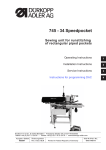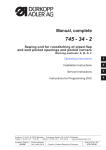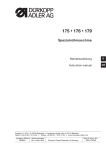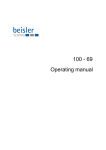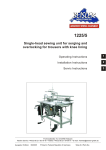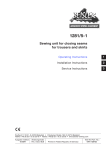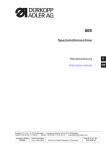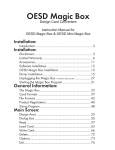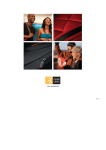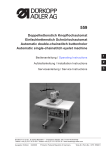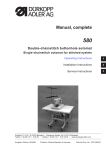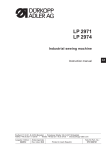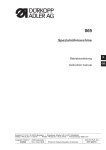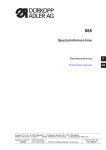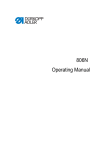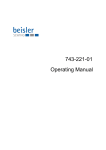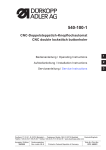Download Adler AG 745-34 Speedpocket Operating instructions
Transcript
745 - 34 Speedpocket Sewing unit for runstitching of rectangular piped pockets Operating Instructions 1 Installation Instructions 2 Service Instructions 3 Instructions for programming DAC 4 Postfach 17 03 51, D-33703 Bielefeld • Potsdamer Straße 190, D-33719 Bielefeld Telefon +49 (0) 521 / 9 25-00 • Telefax +49 (0) 521 / 9 25 24 35 • www.duerkopp-adler.com Ausgabe / Edition: 06/2007 Änderungsindex Rev. index: 02.0 Printed in Federal Republic of Germany Teile-Nr./Part.-No.: 0791 745171 All rights reserved. Property of Dürkopp Adler AG and copyrighted. Reproduction or publication of the content in any manner, even in extracts, without prior written permission of Dürkopp Adler AG, is prohibited. Copyright © Dürkopp Adler AG - 2007 Foreword This instruction manual is intended to help the user to become familiar with the machine and take advantage of its application possibilities in accordance with the recommendations. The instruction manual contains important information on how to operate the machine securely, properly and economically. Observation of the instructions eliminates danger, reduces costs for repair and down-times, and increases the reliability and life of the machine. The instruction manual is intended to complement existing national accident prevention and environment protection regulations. The instruction manual must always be available at the machine/sewing unit. The instruction manual must be read and applied by any person that is authorized to work on the machine/sewing unit. This means: – – – Operation, including equipping, troubleshooting during the work cycle, removing of fabric waste, Service (maintenance, inspection, repair) and/or Transport. The user also has to assure that only authorized personnel work on the machine. The user is obliged to check the machine at least once per shift for apparent damages and to immediatly report any changes (including the performance in service), which impair the safety. The user company must ensure that the machine is only operated in perfect working order. Never remove or disable any safety devices. If safety devices need to be removed for equipping, repairing or maintaining, the safety devices must be remounted directly after completion of the maintenance and repair work. Unauthorized modification of the machine rules out liability of the manufacturer for damage resulting from this. Observe all safety and danger recommendations on the machine/unit! The yellow-and-black striped surfaces designate permanend danger areas, eg danger of squashing, cutting, shearing or collision. Besides the recommendations in this instruction manual also observe the general safety and accident prevention regulations! General safety instructions The non-observance of the following safety instructions can cause bodily injuries or damages to the machine. 1. The machine must only be commissioned in full knowledge of the instruction book and operated by persons with appropriate training. 2. Before putting into service also read the safety rules and instructions of the motor supplier. 3. The machine must be used only for the purpose intended. Use of the machine without the safety devices is not permitted. Observe all the relevant safety regulations. 4. When gauge parts are exchanged (e.g. needle, presser foot, needle plate, feed dog and bobbin) when threading, when the workplace is left, and during service work, the machine must be disconnected from the mains by switching off the master switch or disconnecting the mains plug. 5. Daily servicing work must be carried out only by appropriately trained persons. 6. Repairs, conversion and special maintenance work must only be carried out by technicians or persons with appropriate training. 7. For service or repair work on pneumatic systems, disconnect the machine from the compressed air supply system (max. 7-10 bar). Before disconnecting, reduce the pressure of the maintenance unit. Exceptions to this are only adjustments and functions checks made by appropriately trained technicians. 8. Work on the electrical equipment must be carried out only by electricians or appropriately trained persons. 9. Work on parts and systems under electric current is not permitted, except as specified in regulations DIN VDE 0105. 10. Conversion or changes to the machine must be authorized by us and made only in adherence to all safety regulations. 11. For repairs, only replacement parts approved by us must be used. 12. Commissioning of the sewing head is prohibited until such time as the entire sewing unit is found to comply with EC directives. 13. The line cord should be equipped with a country-specific mains plug. This work must be carried out by appropriately trained technicians (see paragraph 8). It is absolutely necessary to respect the safety instructions marked by these signs. Danger of bodily injuries ! Please note also the general safety instructions. Index Page: Preface and general safety instructions Part 1: Operating Instructions 745-34 Speedpocket (Edition: 06/2007) 1. 1.1 1.2 1.3 1.4 Description of product . Description of proper use . Brief description . . . . . . Technical data . . . . . . . Optional equipment . . . . 2. 2.1 2.2 2.3 2.4 2.5 2.6 2.7 2.8 2.9 2.10 2.10.1 2.10.2 2.11 2.12 2.13 2.14 2.14.1 2.14.2 2.14.2.1 2.14.2.2 3. 3.1 3.2 3.3 3.4 3.5 3.6 3.6.1 3.6.2 3.6.3 3.7 . . . . . . . . . . . . . . . . . . . . . . . . . . . . . . . . . . . . . . . . . . . . . . . . . . . . . . . . . . . . . . . . . . . . . . . . . . . . . . . . . . . . . . . . . . . . . . . . . . . . . . . . . . . . . . . . . . . . . . . . . . . . . . . . . . . . . . . . . . . . . . . . . . . . . . . . . . . . . . . . 3 3 3 4 5 Operation Swinging the folding station aside. . . . . . . . . . . . . . . . . . . Pushing the covering hood back and removing the fabric sliding Tilting the machine head up . . . . . . . . . . . . . . . . . . . . . . Needles and threads . . . . . . . . . . . . . . . . . . . . . . . . . . Threading in the needle thread . . . . . . . . . . . . . . . . . . . . Winding up the hook thread . . . . . . . . . . . . . . . . . . . . . . Changing the bobbins . . . . . . . . . . . . . . . . . . . . . . . . . . Thread tension . . . . . . . . . . . . . . . . . . . . . . . . . . . . . . Stacking control . . . . . . . . . . . . . . . . . . . . . . . . . . . . . Corner knife station . . . . . . . . . . . . . . . . . . . . . . . . . . . Swinging the corner knife station out / in . . . . . . . . . . . . . . Adjusting the corner knives . . . . . . . . . . . . . . . . . . . . . . Reference position - Starting the sewing cycle - Quick stop . . . Flap and piping projection . . . . . . . . . . . . . . . . . . . . . . . Piping strip length . . . . . . . . . . . . . . . . . . . . . . . . . . . . Working method . . . . . . . . . . . . . . . . . . . . . . . . . . . . . Working method (production of trousers) . . . . . . . . . . . . . . Sewing with flap . . . . . . . . . . . . . . . . . . . . . . . . . . . . . Sewing without light-barrier . . . . . . . . . . . . . . . . . . . . . . Sewing with light-barrier . . . . . . . . . . . . . . . . . . . . . . . . . . . . sheet . . . . . . . . . . . . . . . . . . . . . . . . . . . . . . . . . . . . . . . . . . . . . . . . . . . . . . . . . . . . . . . . . . . . . . . . . . . . . . . . . . . . . . . . . . . . . . . . . . . . . . . . . . . . . . . . . . . . . . . . . . . . . . . . . . . . . . . . . . . . . . . . . . . . . . . . . . . . . . . . . . . . . . . . . . . . . . . . . . . . . . . . . . . . . . . . . . . . . . . . . . . . . . . . . . . . . . . . . . . . . . . . . . . . . . . . . . . . . . . . . . . . . . . . . . . . . . . . . . . . . . . . . . . . . . . . . . . . . . . . . . . . . . . . . . . . . . . . . . . . . . . . . . . . . . . . 7 8 11 12 15 16 17 19 20 21 22 23 24 25 26 27 28 31 31 33 Functions and operation of the optional equipment Remaining thread monitor . . . . . . . . . . . . . . . . . . Aligning the light barriers of the bobbin thread monitor . Blowing device . . . . . . . . . . . . . . . . . . . . . . . . . Bundle clamp . . . . . . . . . . . . . . . . . . . . . . . . . . Mounting table extensions . . . . . . . . . . . . . . . . . . Vacuum blower . . . . . . . . . . . . . . . . . . . . . . . . . Checking the nominal voltage of the vacuum blower . . Direction of rotation of the vacuum blower . . . . . . . . Connection to the factory-own vacuum system . . . . . . nd Mounting the 2 light barrier . . . . . . . . . . . . . . . . . . . . . . . . . . . . . . . . . . . . . . . . . . . . . . . . . . . . . . . . . . . . . . . . . . . . . . . . . . . . . . . . . . . . . . . . . . . . . . . . . . . . . . . . . . . . . . . . . . . . . . . . . . . . . . . . . . . . . . . . . . . . . . . . . . 36 37 39 40 41 42 43 43 44 45 . . . . . . . . . . . . . . . . . . . . . . . . . . . . . . . . . . . . . . . . . . . . . . . . . . . . . . . . . . . . . . . . . . . . . . . . . . . . . . . . . . . . . . . . . . . . . . . . . . . . . . . . . . . . . . . . . . . 1 4. 4.1 4.2 Maintenance Cleaning . . . . . . . . . . . . . . . . . . . . . . . . . . . . . . . . . . . . . . . . . . . . . . . . . . Weekly lubrication . . . . . . . . . . . . . . . . . . . . . . . . . . . . . . . . . . . . . . . . . . . . 46 48 1. Description of product 1.1 Description of proper use The 745-34 Speedpocket is a sewing unit determined to sew light to medium-weight material, i.e. fabrics made of textile fibers or leather. These materials are used in the clothing industry. Generally only dry material should be processed with this machine. It should not contain any hard objects. In general, the seam is made with core thread, Polyester fibre or cotton threads. The dimensions for needle and hook threads can be taken from the table in chapter 2.4. Before using any other threads it is necessary to estimate the consequent risks and to take corresponding safety measures, if required. This sewing unit must be installed and operated in dry and well-kept rooms only. If it is operated in other rooms, which are not dry and well-kept, further measures, which are to be agreed upon, can become necessary (see EN 60204-31:1999). We, as a manufacturer of industrial sewing machines, take it for granted that at least semi-skilled operators will be working on our products so that we can assume that all usual operations and, where applicable, their risks are known to them. 1.2 Brief description The Dürkopp-Adler 745-34S is a sewing unit for runstitching of rectangular piped pockets. The piping strips and additional parts are fed manually. Pocket length 20-200 mm (with flap 180 mm max.). Machine head – Twin needle lockstitch execution – Large vertical hooks – Externally driven center knife – Thread trimming device for needle and hook threads – Thread monitor for the needle threads – DC direct sewing drive Step motors for the material feed New generation of control “DAC III” (DÜRKOPP ADLER Control) The comprehensive testing and monitoring system MULTITEST is integrated in the DAC III. A microcomputer assumes the control tasks, monitors the sewing cycle and indicates faulty operation and malfunctions on the display. 5 1 Optional equipment See chapter 1.4 (Optional equipment of class 745-34S). Sewing equipment and folders Information about sewing equipment and folders for the various fields of application can be taken from the Equipment Sheets of class 745-34S. Please address your enquiries to the DÜRKOPP-ADLER-sales offices. 1.3 Technical data Machine head: Needle system: Needle distance: Needle size: Class 0246 992003 2134-85 10, 12 mm Nm 80 to Nm 110 Threads: see table chapter 2.4 Stitch type: Twin needle lockstitch Speed: min. 2000 r/ min max. 3000 r/ min min. 2.0 to 3.0 mm Stitch length: Number of stitches condensed stitches: Number of stitches bartack stitch: Number of stitches condensed stitches / bartack: 6 1 - 10 stitches 0 - 5 stitches 0.5 - 3.0 mm Pocket length: max. 200 mm Operating pressure: Air consumption: 6 bar approx. 6 NL per work cycle Nominal voltage: Dimensions: Working height: 1 x 230 V (50/60 Hz) 1540 x 1120 x 1200 mm (L x W x H) 790...980 mm (upper edge of table top) Weight: 240 kg 1.4 Optional equipment Order No. Optional equipment 0792 011161 Mounting kit K Flap clamp, left, for jackets 0792 011162 Mounting kit K Flap clamp, right, for trousers 0745 427514 Pincer stacker Universal stacking device (pincer stacker) for stacking to the side 0797 003031 Pressure line Connection hose to the pneumatic supply line with corresponding couplings 0246 497534 Remaining bobbin thread monitor 0745 597694 Bundle clamp with rest table for trousers parts. incl. table extension (large). 0745 597604 Blowing device For blowing out the finished parts. 0745 597964 Vacuum blower for the suction device, if there is no central vacuum system. 0745 597984 Suction device (Vacuum) For more exact positioning of the material , for connection to the central vacuum system. Note: If there is no central vacuum system available, the vacuum blower has to be ordered in addition. 0745 598154 Kit 2 light barrier for applications Trouser / Jacket 1 nd 7 1 2 8 2. 2.1 Operation Swinging the folding station aside For work at the sewing point (threading in the needle threads, needle change etc.) the whole folding station with folder and light-barriers can be swung out to the right side. – Swing the complete folding station 1 with folder to the right. Hint: With the sewing unit turned on, a safety message appears on the screen of the control panel. Err 9002 Folding station swung out – The sewing point is freely accessible. 1 Swinging the folding station back – Swing the folding station back. ATTENTION ! After the folding station has been swung back, it must lock in catch 2. 9 2.2 Pushing the covering hood back and removing the fabric sliding sheet Caution: Danger of injury! Switch the main switch off . Push the covering hood back and remove the fabric sliding sheets only with the sewing unit switched off. – 2 Switch the main switch off. 3 1 Pushing the covering hood back – Loosen screw 1 of covering hood 2. – Push the covering hood 2 to the left. ATTENTION! Push the covering hood 2 to the left only so far that the cable 3 of the light-barrier is not damaged. – – Push the covering hood 2 back to the right again. Secure the covering hood 2 against displacement with the screw 1. Note! With the covering hood pushed back, a safety message appears on the screen of the control panel. Err 9004 Covering hood not pushed back. 10 6 5 4 1 Removing the fabric sliding sheet For changing the hook thread bobbins: – Swing the folding station 4 out by 90°. – Lift the fabric sliding sheet 6 in the area of pin 5 and swivel it away to the left. For complete removal (for maintenance and setting work): – Remove the fabric sliding sheet. 11 1 4 12 1 3 2 5 2.3 Tilting the machine head up For maintenance work the machine head can be tilted up. For this purpose the transport carriage must be in its rear position. Caution: Danger of injury! Switch the main switch off. Tilt the machine head up only with the main switch turned off. Tilting the machine head up – Remove the covering hood 1. For this purpose lift the covering hood at the front so that the locking is released. Lift the covering hood off carefully. – Swing the folding station 2 out by 90°. – Swivel the locking lever 4 up. – Lift the fabric sliding sheet 3 at the front and swivel it to the left. – Lift the machine head in the area of the head cover and tilt it up carefully until catch 5 locks. The latch snaps in additionally. The space under the machine table is accessible for cleaning work. 1 Swinging the machine head back – Lift catch 5. – Swing the machine head back carefully. Caution: Danger of injury! Hold the machine head tight until it is completely at rest when lowered. Danger of squashing your fingers between machine head and table top. – – – – Insert the fabric sliding sheet. Swivel the locking lever 4 down. Tilt the folding station 2 back and insert it. Put the covering hood 1 on again. 13 2.4 Needles and Threads Needle system: Recommended needle size: 2134-85 Nm 90 for thin material Nm 100 for medium-weight material Nm 110 for heavy-weight material High sewing security and good sewability are achieved with the following core threads: – Two-ply Polyester Continuous Polyester core-spun (e.g. Epic Poly-Poly, Rasant x, Saba C, ...) – Two-ply Polyester Continuous Cotton core-spun (e.g. Frikka, Koban, Rasant, ...) In case these threads are not available, the Polyester fibre or cotton threads listed in the table can also be sewn. Often two-ply core threads are offered by the thread manufacturers with the same designation as three-ply Polyester fibre threads (3cyl.-spun). This causes uncertainty with regard to twisting and thread thickness. When in doubt unravel the thread and check if it is twisted 2- or 3-ply. The label no. 120 on the thread reel of a core thread corresponds e.g. to the thread size Nm 80/2 (see table values in brackets). In case of monofilament threads it is possible to use needle threads and hook threads of the same size. The best results are achieved with soft and elastic threads (software) of the thread size 130 Denier. Recommended thread sizes: Needle size Nm Core thread Core thread Needle thread Hook thread Needle thread Hook thread Polyester continuous Label No. Polyester core-spun Label No. Polyester continuous Label No. Cotton core-spun Label No. 90 120 (Nm 80/2) 120 (Nm 80/2) 120 (Nm 80/2) 120 (Nm 80/2) 100 100 (Nm 65/2) 100 (Nm 65/2) 100 (Nm 65/2) 100 (Nm 65/2) 110 75 (Nm 50/2) 75 (Nm 50/2) 75 (Nm 50/2) 75 (Nm 50/2) Needle size Nm Polyester fibre thread (3cyl.-spun) Cotton thread Needle thread Hook thread Needle thread Hook thread 90 Nm 80/3-120/3 Nm 80/3-120/3 Ne 50/3-70/3 Ne 50/3-70/3 100 Nm 70/3-100/3 Nm 70/3-100/3 Ne 40/3-60/3 Ne 40/3-60/3 110 Nm 50/3-80/3 Nm 50/3-80/3 Ne 40/4-60/4 Ne 40/4-60/4 14 B B B B B B Changing the needles 1 4 5 2 3 1 Caution: Danger of injury! Switch the main switch off. Change the needles only with the main switch turned off. Danger of cutting your fingers! Do not reach into the area of the center knife 3 when changing the needles. – – – – Swing the folding station aside (see chapter 2.1) The needles are freely accessible. Loosen screw 2 and remove the needle from the needle holder 1. Insert the new needle in the drill-hole of needle holder 1 as far as it will go. ATTENTION! Seen from the operator’s side, the hollow groove 4 of the left needle must point to the left and the hollow groove 5 of the right needle to the right (see sketch). Tighten screw 2. ATTENTION! After changing over to another needle size the needle protection on the hook has to be readjusted (see Service Instructions). Hint: The standard needle size of class 745-34 is Nm 100 . 15 1 2 3 4 5 6 7 8 17 16 9 15 14 13 12 16 11 10 2.5 Threading in the needle thread Caution: Danger of injury! Switch the main switch off. Thread needle threads in only with the sewing unit switched off. The threading-in of the needle threads is done in ascending numerical order, as shown in the illustrations opposite: – Swing the folding station aside Left needle – Put the thread reel on the thread reel holder. – Thread the thread from the thread reel through the drill-hole 1 of the thread reel holder. – Guide the thread through the guide 2. – Guide the thread through the drill-hole in support plate 3. – Guide the thread through the guide 5. – Guide the thread through the tensions discs of needle thread tension 6. – Guide the thread through the thread controller spring 8. – Guide the thread through the drill-hole in support plate 10. – Thread the thread through the drill-hole in thread lever 17. – Guide the thread downward through the thread puller 16. – Thread the thread through the guide 15, through the needle thread monitor 14 and through the thread guide 13 (not visible). – Thread the thread through the guide 12 (not visible), through the drill-hole in the needle holder and through the eye of the needle. Right needle – Put the thread reel on the thread reel holder – Thread the thread from the thread reel through the drill-hole 1 of the thread reel holder. – Guide the thread through the guide 2. – Guide the thread through the drill-hole in the support plate 3. – Thread the thread through the tension disc of the needle thread tension 4. – Thread the thread through the guides 5 and 7. – Guide the thread through the thread controller spring 9. – Guide the thread through the drill-hole in support plate 10. – Thread the thread through the drill-hole in the thread lever 17. – Thread the thread downward through the thread puller 16, through the guide 15, through the needle thread monitor 11 and through the thread guide 13. – Thread the thread through the guide 12 (not visible), through the drill-hole in the needle holder and through the eye of the needle. – Clamp the threads in the needle thread catcher and cut them off. 17 1 2.6 Winding up the hook thread 1 4 3 2 The external bobbin winder allows to wind up the hook threads independent of sewing. – Remove remaining thread from the winder hubs before winding-up. – Put the thread reel on the thread reel holder. – Thread the thread through the drill-hole 1 of the unwinding arm (see picture on the left). – Guide the thread through the guide 4. – Guide the thread through the bobbin thread tension 2. – Prewind the thread to the right in the front and hind reserve grooves of the bobbin hub. The full reserve grooves guarantee a secure winding even with monofilament threads. – Press the bobbin retainer 3 against the bobbin hub. The winder starts. After reaching the set bobbin filling quantity the winder stops automatically. See the Service Instructions for setting the bobbin filling quantity. 18 2.7 Changing the bobbins 2 1 1 ATTENTION! Switch the main switch off before changing the bobbins. After a certain number of seams the hook thread stock on the bobbin is used up. With the remaining thread monitor switched on the message Err 9602 appears on the screen. After the corner incision the workpiece is moved out or stacked respectively. The sewing unit can only be restarted after the bobbin change. (See chapter “Setting the number of stitches”). Removing the empty bobbin – Switch the main switch off. – If the transport carriage is in front position, push it to the rear by hand. – Swing the folding station aside. – Lift the fabric sliding sheet and swivel it to the left (see chapter 2.2). – Lift the upper part of the bobbin case in the area 2. The bobbin case retainer 1 is lifted simultaneously. – Remove the upper part of the bobbin case together with the empty bobbin. – Remove the empty bobbin from the upper part of the bobbin case. 19 2 5 20 6 1 Inserting a full bobbin – Insert a full bobbin in the upper part of the bobbin case 2. – Pull the thread through slit 5 under tension spring 6. – Pull a thread length of approx. 4 cm out of the upper part of the bobbin case. When the thread is being pulled off, the bobbin must turn in the direction of the arrow (in the opposite direction to the hook rotation). – Insert the upper part of the bobbin case 2 with the full bobbin in the lower part of the bobbin case. – Close the bobbin case retainer 1. – Put the fabric sliding sheet on again. – Switch the main switch on. – Start a new sewing cycle. The stitch counting has been reset to the old value. (see Programming Instructions “Adjusting programs) 2.8 Thread tension The interlacing of the threads must lie in the middle of the workpiece. Thick and hard material requires a tighter thread tension than thin and soft material. In case of thin material a too high thread tension can lead to undesired ruffling and thread breakage. 4 3 1 2 1 5 6 Setting the brake spring 4: In case of a positioned stop of the machine head the brake spring 4 avoids an after-run of the hook thread bobbin. – Set the brake spring 4 by alignment. The brake power is adjusted correctly when the brake spring 4 projects approx. 1 mm above surface 3. – When setting the tension spring 6 the brake power is to be taken into account. Setting the tension spring 6: – First set only a minimum tension of leaf spring 6 at the adjusting screw 5. Increase the hook thread tension: Turn to the right Reduce the hook thread tension: Turn to the left – With the bobbin inserted and the hook thread threaded through the throat plate a uniform and easy pull-off must be assured. Setting the needle thread tension: – Adjust the needle thread tension until a uniform stitch pattern is achieved. – Adjust the tension of the needle threads at knurled nut 1 (right needle thread) and knurled nut 2 (left needle thread). Increase the needle thread tension: Turn to the right Reduce the needle thread tension: Turn to the left 21 2.9 Stacking control The reflected light-barrier 1 monitors the stacking of the sewn workpiece. The transport carriage does not run back before the workpiece has been moved out correctly. 3 2 1 If the workpiece is not moved out correctly, the light beam between the reflected light-barrier 3 and the reflector 1 remains interrupted. A renewed starting is not possible. After stepping on the pedal an error message appears. If theBTFE foil 2 is worn, it has to be replaced. TheBTFE foil has the following functions: · · Better withdrawal of material Light beam interruption when the cover is open Caution: Danger of injury! Do not reach into the run area of the transport carriage when removing the workpiece. In case of sewing programs with automatic carriage return the transport carriage moves to the front after release of the light beam. – Remove the workpiece out of the light beam. A new sewing cycle can be started. ATTENTION ! For a secure function of the stacking control clean the lens of the reflected light-barrier with a soft cloth once a day. 22 2.10 Corner knife station The 745-34S is equipped with a manual corner knife station. The setting of the corner knives with regard to the pocket length is done by adjusting the knife block. The distance of the corner knives to the seam is manually adjustable. The whole knife block can be tilted out in order to make adjusting and service work possible. 1 23 2.10.1 Swinging the corner knife station out / in 1 Caution: Danger of injury! Switch the main switch off. Swing the corner knife station out only with the sewing unit switched off. Swinging the corner knife station out – Swing the corner knife station 1 out to the left. The knives are accessible for adjusting and service work. Swinging the corner knife station in – Swing the corner knife station 1 back under the sewing unit and let it catch. ATTENTION! The corner knife station must audibly lock when being pushed in. Hint: If the corner knife station is swung out with the sewing unit switched on, the following message appears: Err 24 9001 2.10.2 Adjusting the corner knives 4 3 2 1 6 5 Caution: Danger of injury! Switch the main switch off. Adjust the corner knives only with the sewing unit switched off. – 1 Swing the corner knife station out (see chapter 2.10.1) Setting the angle of the corner knives The angle of the corner knife is adjusted by turning the knife blocks 2 and 4. – Loosen screws 1 and 3. – Turn the knife blocks 2 and 4 equally. – Tighten screws 1 and 3. – Adjust the angle of the other pair of knives correspondingly. Height of the corner knives The corner knives are not height-adjustable. The knives always cut through completely. – Seam beginning Swing the corner knife station in (see chapter 2.10.1). Seam end Straight pocket corners Right and left corner knife incisions lie parallel Position of the adjustable knife block The position of the adjustable knife block corresponds to the seam length L1. – Loosen clamping lever 5 and set seam length L1 on scale 6. – Tighten clamping lever 5. 25 2.11 Reference position - Starting the sewing cycle - Quick stop Reference position The reference position is necessary in order to get a defined initial position. – Switch the main switch on. The control is initialized. – The display shows briefly bF4 (Program version) 745 (Program number) – The control checks whether the transport carriage is in its rear end position. If not, the message “Reference run” is shown on the screen. rEF – – Step back on the pedal. The reference run starts. The transport carriage runs in its rear end position. The display changes over to the seam program set before (e.g. L1 -180 mm). Starting the sewing cycle – Step forward on the pedal. By repeated stepping on the left pedal the various steps of the positioning sequence are started sequentially. – For positioning corrections: Step back on the pedal. The last step of the positioning sequence is undone. A new positioning can be made. – Step forward on the pedal. The sewing cycle is started. Quick stop The safety system of the 745-34S offers two possibilities for an immediate shut-down of the sewing unit in case of faulty operation, needle breakage, thread breakage etc.: – Step back on the pedal. The current step of the positioning sequence or the sewing cycle respectively is stopped immediately. The following message appears: Err 26 9601 – Step back on the pedal again. The carriage runs out of the feeding area. – Press key “RST” on the control panel. The current sewing cycle is stopped. 2.12 Flap and piping projection For the unhindered passage of the workpieces at the folder the maximum projections of piping, flap and material thickness (see sketch) must not be exceeded. Please take the maximum allowable piping strip widths for the respective sewing equipment (E-No.) from the Equipment Sheets of the 745-34. 1 b a 2 3 1: Folder 4 5 3 6 2: Piping projection, max. 40 mm 3: Flap 4: Guide plate on the folder 5: Flap projection, max. 20 mm 6: Piping strip NA NA: Seam distance 1 a, b: Material passage on the folder Setting the sewing depth of flap 1 Stop guide 3 determines the sewing depth and thus the flap projection. – Loosen screws 2 and 4. – Adjust stop guide 3 – Tighten screws 2 and 4. 1 2 3 4 27 2.13 Piping strip length The length of the piping strip must be dimensioned in such a way that it projects approx. 20 mm beyond the seam beginning and seam end. Thus the piping strip length is as follows: Piping strip length = Sewing length + 2 x 20 mm 28 2.14 Working method Working method A Remarks Piped pockets, manual positioning of piping strips, flaps and other additional parts On the following pages the working method is described. The description is divided into the following items: Positioning points This item indicates which positioning points are used for the various workpieces (e.g. left and right pieces). Aligning the positioning aids This section describes the adjustment and alignment of the positioning aids (e.g. positioning marks, marking lamps, stop guides etc.). 1 Positioning and starting the sewing cycle Under this item the individual positioning steps are listed with common positioning examples. Caution: Danger of injury! Do not reach under the downholder, the feeding clamp and the folder during the positioning process. 29 2.14.1 Working method (Production of trousers) Possible processing variants – Front trousers pockets with pocket bag positioned below – Hind trousers pockets with or without flap, with pocket bag positioned below Positioning method Example: Hind trousers without flap, with pocket bag positioned below 1st step: – Select the pocket program on the control panel – Push the pocket bag under pocket bag clamp 1 and position it at the marks 2. As marks you can use e.g. adhesive tape attached to the fabric sliding sheet. 2nd step: – Position hind trousers at the “rear positioning point” 4 and at mark 3. – Touch the pedal. The hind trousers is firmly clamped in its position by the fabric downholder 5. – Smooth out the clamped hind trousers in the area of the dart. 3rd step: – Touch the pedal. The feeding clamps run forward and lower onto the workpiece. A separate lowering of the clamp halves can be programmed. For example: the right clamp lowers and the fullness from the trousers is manually smoothed out to the left. Then lower the left clamp. – Position the piping strip 7 on the feeding clamps flush at the front edges 8. The alignment of the various piping types on the feeding clamps is described more precisely in the following. See “Positioning the piping strip”. – Touch the pedal. The folder 6 lowers. – Touch the pedal once again. The sewing cycle starts. 30 1st step: 1 2 2nd step: 1 5 3 4 3rd step: 6 7 8 31 Positioning the piping strip Double piping: – Position the piping strip centered on the feeding clamps and flush at the front edges. Left single piping with separately positioned right facing: – Position the piping strip on the left feeding clamp flush with the cutting line. – Position the facing on the right feeding clamp. This positioning method requires the flap clamp “right” (Order No.0792 011162) available as optional equipment. – The edges 1 and 2 have to be sufficiently caught by the needle, but must not be cut by the center knife. 1 2 Left single piping with grown-on facing – Position the piping strip at the stop guide 3 on the left folding sheet. ATTENTION! In case of grown-on facings the right folding sheet must not close. Pull off the hose coupling from the right feeding clamp . 3 32 2.14.2 Sewing with flap For the simultaneous sewing-in of flaps or other additional parts the following optional equipment is required according to the field of application: Production of trousers: Right flap clamp (Order No. 0792 011162) Or Left flap clamp (Order No. 0792 011161) 2.14.2.1 Sewing without light-barrier 1 2 1 Form stop for the flap The unmachined part 1 is delivered with the flap clamp 2. It has to be machined as a form stop corresponding to the flap used. ATTENTION! The flap length must correspond to the desired length of the pocket opening. 33 Sewing with the flap at the right (production of trousers) – For the production of trousers always position the flap at the “Rear positioning point” (light spot 5). The “Rear positioning point” applies as a fixed point also for other sewing units (further flap lengths). – Attach the positioning mark 4 for the hind trousers to the fabric sliding sheet. – The sketch shows the positioning of a right hind trousers part 3 with flap. – Position the left hind trousers parts in reflected image. The position of the flap remains unchanged. 3 4 5 34 4 2.14.2.2 Sewing with light-barrier 2 1 1 When attaching flaps, seam beginning and seam end are recognized by a light-barrier. Positioning the flap The positioning marks 1 and 2 on the folder limit the sewing area for the attaching of flaps. – Always position the flaps within the marked area. If the flap is not positioned correctly, the error message Err 9721 or Err 9722 appears. Correction of seam beginning and seam end The correction of the seam beginning (NA) and seam end (NE) when sewing with light-barrier is done in the pocket correction program (see Programming Instructions). 35 3. Functions and operation of the optional equipment In this chapter the function and the operation of the most important optional equipment is described. 3.1 Remaining thread monitor The remaining thread monitor monitors the left and right hook thread bobbin with the infrared reflected light barriers 1 and 2. 3 1 – – – 2 When the bobbin is empty, the light beam transmitted by the light barrier 1 or 2 is reflected by the exposed reflecting surface 3 of the bobbin hub. The display of the control box shows the message “Info 3220" Additionally a flashing symbol indicate the position of the empty bobbin. left bobbin empty right bobbin empty The pocket opening is safely finished with the thread in the reserve groove of the bobbin hub. Caution: Danger of injury! Switch the main switch off. Clean the lenses of the light barriers only with the sewing unit switched off. – – – – 36 Switch the main switch off. Clean the lenses of the light barrier with a soft cloth after every bobbin change. Switch the main switch on. Start a new sewing cycle. 3.2 Aligning the light barriers of the bobbin thread monitor 3 2 1 Standard checking The light barrier holders 3 and 5 are adjusted by the manufacturer in such a way that there is a sufficient safety distance of 3,5 mm between the revolving hooks and the light barriers 2 and 6. ATTENTION ! The bobbin thread monitor is only effective when the function is activated. Activated with parameter 408 =1 (see the programming instructions, chapter 4 “Structure of menu”). – Switch on the main switch. – Choose “Multitest 953“ (see programming instructions, chapter 4 “Structure of menu”). Remove the bobbin case top part with bobbin. Insert an empty bobbin in the bobbin case bottom part. – – ATTENTION ! External light influences the sensitivity of the light barrier. 37 1 If the alignment is correct: a reflection occurs at the surface 7 of the bobbin hub when an empty bobbin rotates. The figure between 1 and 15 will show the intensity of the reflection. If the value is above ( 8 ), then a line (¾) will be displayed. You will hear a beep at the same time. 7 left bobbin right bobbin actual reflection value 3 no line, value <8 line, when value >8 actual reflection value 15 Hint: If the light barriers are set properly, the maximal value of 15 must be reached when the infrared ray hits the surface of the bobbin hub. – To exit the test program switch off the machine. Correction – Clean the lenses of the light barriers 2 and 6 as well as the reflection faces 7 of the bobbin hubs with a soft cloth. – Loosen the clamping screw 1 and 4 respectively. – Align the light barrier 2 and 6 respectively by a minimum rotary motion on the holders 3 or 5. The infrared ray of light barrier 2 or 6 must hit the bobbin hub through the light window in the bobbin case without hindrance. – Tighten clamping screw 1 and 4 respectively. – Check the alignment of the two light barriers once again. 3 2 1 38 3.3 Blowing device The blowing device 1 (Order No. 0745 597604) is used in conjunction with the bundle clamp (Order No. 0745 597604). The blower pipe conveys the workpiece out of the sewing area. 1 1 Y012 P blower 39 3.4 Bundle clamp Bundle clamp (Order No. 0745 597694) 1 2 Caution: Danger of injury ! Risk of suffering from bruising between the arms of the bundle clamps. Function and operation – Step the foot switch down and hold it down. The bundle clamp 1 opens. – Hang the hind trousers parts in bundle clamp 1. The bundle clamp 1 closes. – Release the foot switch. – Place the clamped hind trousers parts on the table extension 2 (Order No. 0745 597674). – After blowing out, the hind trousers part hangs down on the bundle clamp 1 then. 40 3.5 Mounting table extensions 1 3 – – 2 1 Fasten the table extension 3 onto the table top brace with the screws 2. Loosen screws 1 slightly. Create a clearance to the table top by shifting the table extension 3. This clearance is required for the free passage of the positioned pocket bag. 41 3.6 Vacuum blower The vacuum blower has to be ordered under the order number 0745 597624 it is required for an accurate positioning of the workpieces, if no central vacuum system is available. 1 Switching on the vacuum blower – 42 Switch on switch 1 at the control box of the vacuum blower. 3.6.1 Checking the nominal voltage of the vacuum blower (optional equipment) ATTENTION! Any work on the electrical equipment of the sewing unit must only be carried out by electricians or correspondingly instructed persons. The mains plug must be pulled out. 1 1 The adaptation to the local mains voltage has to be done at the terminal strip in control box 1. – Screw off the cover of control box 1. – – – 3.6.2 1 Check the arrangement of the connections to the terminal strip. (see circuit diagram). If necessary, change the connections according to the local mains voltage. Put the cover on the control box 1 again and screw on. Direction of rotation of the vacuum blower The direction of rotation of the vacuum blower can be inverted by exchanging the phase (plug). 43 3.6.3 Connection to the factory-own vacuum system 1 The suction device facilitates the precise feeding and positioning of the workpiece on the work table 1. – Connect the hose of the factory-own vacuum system to the connection valve 3. Note: In case no factory-own vacuum system is available, the vacuum blower (Order No. 0745 597964) has to be ordered in addition. Only filter (white) for use with vacuum blower (Order No. 0745 597964). Seal (black) in front of filter (white) for use with central vacuum system. 2 ATTENTION ! When fitting the vacuum blower ,it is absolutely necessary to remove the seal 2 (black) from the valve. Only the filter (white) should be attached to the valve. 44 3 3.7 Mounting the 2nd light barrier Front view Bottom view S1 = Light barrier LS1 (Test program 952) S2 = Light barrier LS2 (Test program 954) 1 X1 00 t X100t Connection second light barrier 45 4. Maintenance Caution: Danger of injury! Switch the main switch off. Maintenance work must only be done with the sewing unit switched off. 4.1 Cleaning A clean sewing unit protects from malfunctions! Clean and check daily: – Clean the area around the hooks 1 and 2 with the compressed air pistol. 2 8 46 1 7 5 3 4 – On each bobbin change, clean the lenses of the light barriers 5 and 6 of the thread monitor with a soft cloth. – Clean the filter ring 7 on the vacuum valve 8: Blow it with an air gun. 6 Clean and check daily: – Check the water level in the pressure regulator. The water level must not reach the filter element. After screwing in the drain screw 1 blow the water out of the water separator 2 under pressure. The filter element 1 separates dirt and condensed water. After a certain operating time wash the dirty filter tray and the filter element with benzine and blow clean with the compressed air pistol. ATTENTION! Do not use any solvents for washing out the filter tray and the filter element! They destroy the filter tray. 1 1 2 47 3.2 Weekly lubrication For lubricating the sewing unit use exclusively the lubricating oil DA-10. DA-10 can be obtained from the sales offices of DÜRKOPP ADLER AG. Check the oil level in the oil reservoir 3 for lubrication of the machine head – Tilt the machine head up (see chapter 2.3). – The oil level in the oil reservoir 3 must not drop below the “Min” marking. – If necessary, fill some oil up to the “Max” marking through the drill-hole in the inspection glass. Check the oil level in the oil reservoir 5 for lubrication of the hook – Tilt the machine head up (see chapter 2.3). – Fill the oil reservoir 5 with oil up to the “Max” marking through the nipple 4 (see sketch). 3 4 4 48 5 5


















































